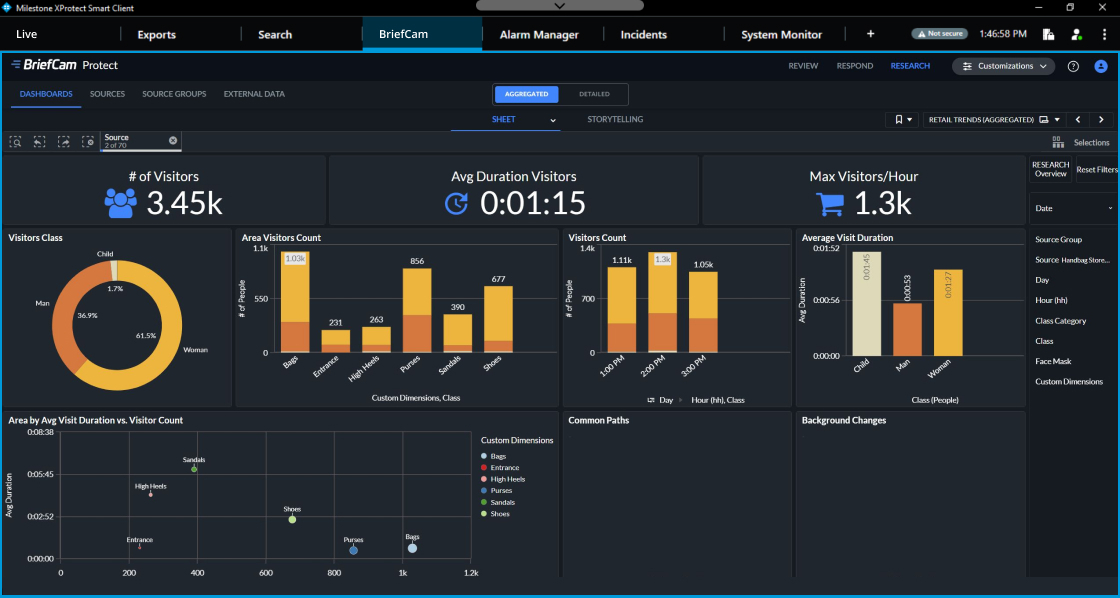How is AI used in video surveillance and other video-based operations? This guide provides a basic overview of how intelligent, AI-powered video analytics software works, what companies like yours can achieve with it, and how to get started.
It is hardly news that artificial intelligence (AI) and other analytics are transforming many aspects of our work lives. But you may be surprised by the dramatic ways intelligent video analytics can enhance surveillance and operational systems.
Intelligent video analytics software uses AI, including machine learning and computer vision, to analyze video footage. It extracts metadata about objects, activities, and events, making video searchable, actionable, and quantifiable.
This kind of analytics transforms passive surveillance into real-time intelligence. Security teams can prevent threats and predict patterns, not just react to events. And that goes far beyond security.
Essentially, intelligent video analytics lets operators:
- Shift from reactive to proactive
Intelligent video analytics transforms surveillance systems into proactive tools that detect threats, anomalies, and patterns. Security teams can move from just reacting to threats to mitigating or even avoiding them.
- Accelerate investigations
Reviewing footage has always been a laborious, time-consuming process. Video analytics accelerates investigations by instantly pinpointing people, vehicles, behaviors, and events of interest.
- Turn insights into business impact
Video analytics software has applications far beyond security. It can track customer and visitor patterns and behaviors to inform decisions that improve daily operations.
Together with Omdia, our team at BriefCam surveyed 140 video analytics software users across North America and Europe. It revealed that over 85% reported that they achieved an ROI within one year of investing in their video analytics solutions.
Far from replacing people, video analytics is augmenting security and operational teams. Industries as diverse as public safety, retail, critical infrastructure and schools are using AI-powered video analytics to solve long-running challenges.
Significant gains in resource, time, and cost management can be achieved with:
Enhanced awareness and response
- Automated real-time alerts enable the instant detection of unusual activity such as unauthorized entry or loitering. Custom rules can be set for specific zones, timeframes, or behaviors so the alerts are always relevant and timely.
- Object and behavior recognition identify people, vehicles, or objects that match suspicious criteria (e.g., a person leaving a bag unattended). It also tracks movement and behavior patterns to flag anomalies such as someone walking against traffic flow or entering restricted areas.
- Integrated response workflows combine analytics with alarm systems, access control, or public address systems to trigger automatic lockdowns or alerts. Operators can accelerate decision-making by viewing live feeds with contextual metadata such as heatmaps, object classifications, or movement trails.
You can ensure perimeters are airtight by setting very specific rules that e.g., can distinguish ordinary behavior from loitering.
Accelerated investigations
- Object and person detection use AI to instantly identify and label people, vehicles, license plates, colors, clothing, or bags, making it easy to locate and track specific people and objects.
- Event detection pinpoints specific actions such as movement in restricted areas, loitering, or object removal. This eliminates hours of manual reviewing.
- Facial recognition finds individuals and tracks them across multiple cameras or time periods.
- Enhanced accuracy thanks to AI reduces errors or oversights by consistently analyzing every frame — and cross-referencing metadata such as time stamps, GPS, and access control logs) to confirm the sequence of events.
Using video analytics such as BriefCam VIDEO SYNOPSIS, post-event investigations that took hours or even days now take minutes.
Improved operational efficiency & planning
- Customer behavior analysis can track foot traffic to see when and how customers move through a space. Heatmaps reveal high-traffic zones, which helps to optimize store layouts and product placements; while dwell-time tracking identifies bottlenecks, overly long queues, or popular areas.
- Optimized staffing and facility management is achieved using analytics to reveal peak hours or understaffed zones. This helps managers plan staff and cleaning schedules more effectively.
- Safety and compliance monitoring detects safety violations, e.g., lack of personal protective equipment (PPE), blocked exits, or people in restricted areas. Companies can also ensure compliance with occupancy limits, hygiene practices, or operational protocols — which is especially vital in regulated industries.
- Long-term strategic decisions — ultimately, intelligent video analytics data helps inform decisions about the bigger picture, whether that is office, store, or facility design, or the need for expansion or relocation.
Video intelligence has applications far beyond security. Management can make significant operational improvements by tracking variables such as customer and employee behavior.
Discover how AI-powered Milestone video solutions are transforming security and beyond around the world including in Law Enforcement, and Critical Infrastructure.
Before choosing an intelligent video analytics surveillance solution, it’s important to evaluate your business goals and technical capabilities. Clarifying your goals will help guide your technology choices, deployment strategies, and success metrics.
Here is a checklist of some of the key considerations:
1. Define the problem you are solving
Start by identifying the core challenges your organization faces. Once you’ve identified the problems, map them to broader business objectives such as:
Improving security
-
- Goal: Reduce investigative time and improve incident resolution.
- Use case: Use AI-powered search and metadata tagging to quickly locate relevant footage.
- Success metric: Reduction in time spent reviewing footage or resolving incidents.
Increasing workplace safety
-
- Goal: Reduce injuries and improve compliance with safety protocols.
- Use case: Monitor high-risk areas like warehouses or loading docks, detect PPE compliance, and analyze near-miss events.
- Success metric: Fewer inury reports or safety violations.
Boosting operational efficiency
-
- Goal: Improve productivity and optimize space usage.
- Use case: Analyze how people move through and use physical spaces, identify bottlenecks, and verify process adherence.
- Success metric: Increased throughput, reduced downtime, or better space utilization.
By tying video analytics to measurable outcomes, you can demonstrate ROI and make informed decisions about scaling or refining your deployment.
2. Choose the right cameras
The success of video analytics starts with selecting the right hardware. The number one consideration is can your current IP cameras handle the task or will upgrades be necessary? Also factor in:
-
- Resolution level: While 4K cameras offer high detail, they also increase GPU load and network strain. You may want to consider dual-stream setups (e.g., one high-res for analytics, one low-res for monitoring) to balance performance and reliability.
- Lighting considerations: AI models often rely on color and contrast. Poor lighting can degrade AI performance, so consider supplemental lighting in low-light areas for optimal AI and analytics performance.
- Resolution level: While 4K cameras offer high detail, they also increase GPU load and network strain. You may want to consider dual-stream setups (e.g., one high-res for analytics, one low-res for monitoring) to balance performance and reliability.
3. Built-in or third-party analytics?
Some video management platforms come with built-in analytics, while others rely on third-party applications that integrate with your existing infrastructure.
-
- Built-in analytics offer simplicity and faster deployment, making them ideal for common use cases like motion detection or basic object tracking.
- Third-party analytics often provide more advanced capabilities such as facial recognition, behavior analysis, or license plate recognition.
- Built-in analytics offer simplicity and faster deployment, making them ideal for common use cases like motion detection or basic object tracking.
Ideally, your platform should support built-in analytics for everyday tasks — with the flexibility to connect to third-party options for more specialized functionalities.
4. Keep your deployment options open
The choice of deployment model can impact costs, performance and scalability. Each option — server-based, edge-based, cloud-based or hybrid — has its advantages depending on bandwidth, privacy requirements, and other variables.
-
- Server-based analytics allow scaling by centrally adding processing power without the need to replace your entire camera network.
- Edge-based analytics analyze the data directly on the camera, which can offer more speed and bandwidth savings.
- Cloud-based analytics offer more flexibility relative to edge-based options. You can add more cameras without infrastructure upgrades.
- Hybrid deployment offers the most flexibility, notably the ability to move workloads between deployments as required.
Choosing a video management software (VMS) platform that supports all options will help deliver the best ROI.
5. Consider the processing and storage requirements
Video analytics generates large volumes of data and metadata that require robust infrastructure. You need to consider the following:
-
- Processing power: AI workloads demand more of your GPU processing. Your infrastructure must be able to scale with the number of cameras and the complexity of analytics (e.g., real-time facial recognition vs. post-event analysis).
- Storage needs: Metadata from analytics such as object detection, timestamps, and behavioral patterns need to be stored for investigations and can accumulate.
6. Choose a future-proof platform
ROI is a key performance metric for any software investment. Obsolescence will derail that very quickly. That’s why a non-proprietary, open platform VMS is so important. You can customize and scale your VMS systems as needs evolve without being limited to a single vendor’s proprietary ecosystem.
Future proof also means Responsible
The use of AI in video surveillance raises important ethical questions, with regulatory bodies moving fast to address them. That is why ensuring your VMS platform meets current and future regulatory requirements should be a top consideration.
In the case of Milestone, we were among the first companies to adopt the G7 Code of Conduct on AI. We train models using anonymized real‑world data and synthetic data to preserve privacy and reduce unwanted bias.
Our XProtect video management software already supports GDPR and FIPS 140-2 compliance through robust data handling and security practices. It's this kind of forward-thinking that could spare you costly retrofitting or even regulatory blowback.
The Milestone product portfolio comprises three core products: XProtect, Arcules, and BriefCam. Together, these cater to all intelligent video analytics needs. You can mix and match depending on your operational maturity and objectives.
- Essential Analytics: Basic features like motion detection and object tracking. Perfect for companies wanting simple video intelligence that's quick to set up.
Our Arcules video surveillance as a service (VSaaS) features built-in analytics with the option to embed edge and camera-to-cloud analytics.
- Core Analytics: More advanced capabilities including line crossing detection, facial recognition, and people counting. Works with third-party applications and suits businesses with specific monitoring needs.
The XProtect video management software (VMS) platform features built-in analytics such as license plate recognition, while being compatible with a broad array of partner integrations. - Advanced Analytics: The most sophisticated option with predictive analytics and VIDEO SYNOPSIS® features. Designed for law enforcement, critical infrastructure, and retail, where detailed insights drive important decisions.
BriefCam offers some of the most advanced video analytics available, including its patented VIDEO SYNOPSIS that condenses hours of footage into a single frame.
All three of our products can be used standalone, while XProtect can be combined with BriefCam or Arcules to form a powerful intelligent video analytics solution. In any scenario, the open-platform flexibility ensures you will be equipped for whatever AI-powered video analytics brings next.
Want to learn more about intelligent, AI-powered video analytics? Download our free guide.

